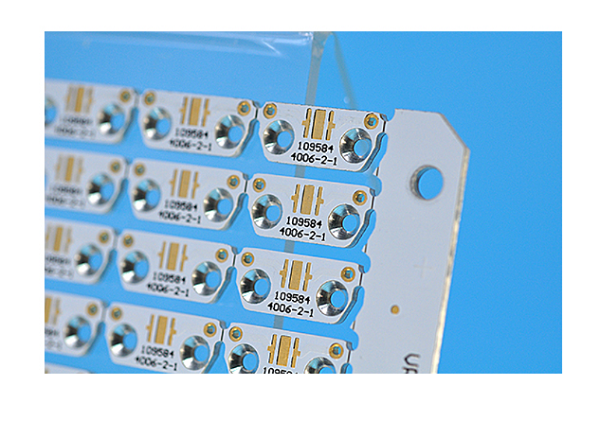Interlayer Circuit Connection in Aluminum-based PCBs: Challenges and Solutions
- Views
- 01 Feb 2024
This is a common question in PCB design and a challenging technical issue. Aluminum-based PCBs, known for their excellent heat dissipation properties, typically consist of three layers: a circuit layer (copper foil), an insulating layer, and a metal base layer (aluminum base). Widely utilized in LED lighting, power equipment, and communication products, achieving interlayer circuit connectivity in aluminum-based PCBs requires the use of a via (through-hole) process. This involves drilling holes in the aluminum base and coating the hole walls with a layer of metal to connect the circuits on different layers.

Can Aluminum-based PCBs Directly Utilize Vias?
Whether aluminum-based PCBs can directly use vias depends on the structure and manufacturing process of the aluminum base.
Single-sided aluminum-based PCBs cannot directly use vias because the metal layer (aluminum sheet) serves as the reference plane for the circuit layer. Direct penetration would lead to short circuits. For interlayer connectivity, single-sided aluminum-based PCBs require insulated vias. These vias involve drilling holes in the aluminum base, coating the hole walls with insulating material, and then depositing a layer of metal to create insulated vias.
Double-sided aluminum-based PCBs can directly use vias, but attention must be paid to hole size, location, and the quality of the metal layer on the hole walls. In this case, both sides of the aluminum base are covered with a circuit layer (copper foil). Vias are drilled through the aluminum base, connecting the circuits on both sides. Vias also serve as channels for heat dissipation, conducting the heat generated by the circuits to the aluminum base.
Multilayer aluminum-based PCBs can also directly use vias but require special structures and processes. These PCBs involve covering one or more layers of circuits on both sides of the aluminum base and drilling vias through the entire structure. Vias in multilayer aluminum-based PCBs play a crucial role in connecting circuits on different layers and facilitating heat dissipation. Due to the thickness and hardness of the aluminum base, manufacturing multilayer aluminum-based PCBs requires specialized drilling and gold plating equipment to ensure hole quality and reliability.
Advantages and Disadvantages of Vias:
Vias offer advantages such as achieving high electrical performance and reliability. However, they come with certain drawbacks:1.Increased Processing Difficulty and Cost:
Vias increase the processing difficulty and cost of aluminum-based PCBs due to the need for specialized drilling and gold plating equipment. Precise requirements for hole size and location are crucial to prevent issues like metal layer detachment or short circuits.
Vias occupy the effective area of the aluminum base, impacting circuit layout and density. This is especially significant for high-power LED fixtures, where vias may reduce the number and brightness of LEDs.
The design requirements for PCB vias mainly include the following points:
1.The diameter of the via hole should be larger than the pin diameter of the component to facilitate insertion and soldering.2.The spacing between vias should be larger than the diameter of the vias to avoid short circuits between vias.
3.The location of vias should avoid signal lines and ground planes to reduce signal interference and impedance changes.
4.The number of vias should be minimized to save PCB space and cost.
Conclusion:
In summary, aluminum-based PCBs can achieve interlayer circuit connections through vias, but the choice of process depends on specific design requirements and cost considerations. PCB vias are an important part of PCB design. Designers must carefully choose the appropriate method. They need to make reasonable selections and designs based on different application scenarios and performance requirements and consider potential problems. The quality of PCB vias also directly affects the reliability and stability of PCB, so strict inspection and testing are required.Interlayer circuit connections in aluminum-based PCBs present challenging technical issues but also represent an innovative avenue of exploration. It is a topic worthy of in-depth study and exploration by PCB designers and manufacturers to meet the needs of increasingly complex and sophisticated electronic products.
Aluminum-based PCB, aluminum led pcb, custom led circuit boards,
Related Blog
- What is Thermal and Electrical Separating Pad in Metal Core PCB?
- LED PCB Assembly Process: Step-by-Step Guide for Beginners
- Why Always Recommend White Solder Mask Black Silkscreen for Aluminum PCB?
- What Materials Are Commonly Used for Manufacturing Lighting PCBs?
- Everything You Should Know About Metal Core Circuit Board
- What Are the Differences Between Ceramic PCB, Metal Core PCB And Standard FR4 PCB?
- Why Choose Best Technology As Your MCPCB Manufacturer?
- What is LED Light Circuit Board and How to Make it?
- When is International Labour Day in 2024 and What are the Significances of It?
- How Does A Convexity Comes Out On Thermoelectric Separation Copper Based PCB?
- Why is Aluminum LED PCB Important for Indoor Growth Lights?
- Application of Metal Core Pcbs in the Development of LED Technology
- Why Choose White Solder Mask for Metal core PCB When Used In LED Devices?
- Understanding Aluminum LED PCBs in 1000w LED Grow Lights
- What Are the Advantages of Metal Core PCB? How to Choose?
- Automotive Light Copper Core Pcb Production Process—testing
- Why Are Metal Core PCBs, Especially Copper Core, Used In Heat-Sensitive Electronics?
- How do aluminum LED PCBs improve LED efficiency?
- What Are the Differences Between Regular and Thermoelectric Separation Copper-Base PCBs?
- Aluminum PCB VS FR-4 Performance Comparison



